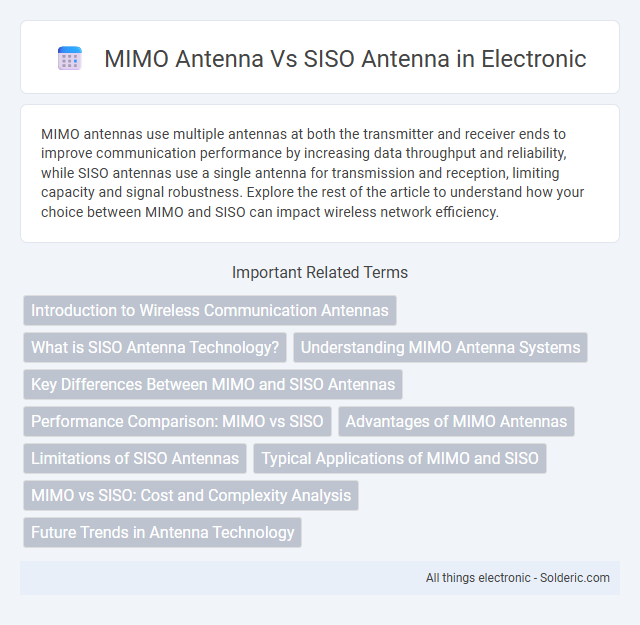MIMO antennas use multiple antennas at both the transmitter and receiver ends to improve communication performance by increasing data throughput and reliability, while SISO antennas use a single antenna for transmission and reception, limiting capacity and signal robustness. Explore the rest of the article to understand how your choice between MIMO and SISO can impact wireless network efficiency.
Comparison Table
| Feature | MIMO Antenna | SISO Antenna |
|---|---|---|
| Definition | Multiple Input Multiple Output uses multiple antennas for transmission and reception | Single Input Single Output uses one antenna for transmission and reception |
| Data Throughput | Higher throughput due to spatial multiplexing | Lower throughput with single data stream |
| Signal Reliability | Improved reliability via diversity gain | Less reliable, prone to fading |
| Range | Extended effective range from signal combining | Limited range |
| Complexity | Higher complexity and cost | Simpler design and lower cost |
| Use Cases | Modern Wi-Fi, 4G, 5G networks | Basic wireless communication, legacy systems |
Introduction to Wireless Communication Antennas
MIMO (Multiple Input Multiple Output) antennas enhance wireless communication by using multiple transmitting and receiving antennas to increase data throughput and signal reliability, while SISO (Single Input Single Output) antennas use a single antenna for both transmission and reception, resulting in simpler design but lower performance in multipath environments. MIMO systems leverage spatial multiplexing and diversity gain to overcome fading and interference, significantly improving wireless network capacity compared to traditional SISO setups. Understanding these differences helps you optimize your wireless communication system for higher efficiency and better coverage.
What is SISO Antenna Technology?
SISO antenna technology uses a single transmit and receive antenna, enabling one data stream over a wireless communication channel. This simpler architecture limits data throughput and signal reliability compared to MIMO systems, which employ multiple antennas to increase capacity and reduce interference. SISO is commonly found in basic wireless devices where lower complexity and cost are prioritized.
Understanding MIMO Antenna Systems
MIMO antenna systems utilize multiple antennas at both the transmitter and receiver to improve communication performance by exploiting multipath propagation, resulting in increased data rates and signal reliability compared to SISO antennas that use a single antenna for transmission and reception. By transmitting independent data streams simultaneously over the same frequency band, MIMO enhances spectral efficiency and mitigates fading effects. This technology is fundamental in modern wireless standards such as LTE and Wi-Fi, enabling higher throughput and better coverage in complex environments.
Key Differences Between MIMO and SISO Antennas
MIMO antennas use multiple transmitting and receiving antennas to improve communication performance by increasing data throughput and reducing signal fading, unlike SISO antennas that rely on a single transmitter and receiver. MIMO technology enhances spectral efficiency and reliability by exploiting spatial multiplexing and diversity gains, while SISO systems have limited capability in handling multi-path environments. Your network experience can significantly benefit from MIMO antennas due to their superior ability to maintain strong connections in challenging wireless conditions.
Performance Comparison: MIMO vs SISO
MIMO (Multiple Input Multiple Output) antennas significantly outperform SISO (Single Input Single Output) antennas by utilizing multiple spatial streams to increase data throughput and signal reliability. Your wireless system benefits from improved spectral efficiency and reduced signal fading in MIMO configurations, enabling faster and more stable connections compared to the single transmission path of SISO. In environments with multipath propagation, MIMO technology enhances coverage and capacity, making it ideal for modern high-speed communication demands.
Advantages of MIMO Antennas
MIMO (Multiple Input Multiple Output) antennas significantly enhance wireless communication by increasing data throughput and spectral efficiency compared to SISO (Single Input Single Output) antennas. They improve signal reliability and reduce multi-path fading through spatial multiplexing and diversity techniques, resulting in faster and more stable connections. This technology is crucial for modern applications like 4G, 5G, and Wi-Fi, supporting higher capacity and better user experience.
Limitations of SISO Antennas
SISO antennas face significant limitations in wireless communication due to their inability to exploit multipath propagation for increased data throughput and signal reliability, leading to lower spectral efficiency compared to MIMO systems. Single input-single output configurations suffer from reduced capacity and are more susceptible to fading and interference in complex environments. These constraints result in limited performance in dense urban areas and high-demand applications where MIMO antennas provide enhanced spatial diversity and channel capacity.
Typical Applications of MIMO and SISO
MIMO antennas are widely used in advanced wireless communication systems such as 4G LTE, 5G NR, Wi-Fi 6, and multiple-input multiple-output systems to enhance data throughput, signal reliability, and spectrum efficiency in dense urban environments and smart devices. SISO antennas remain common in simpler, low-cost applications like traditional FM radio, basic IoT sensors, and legacy cellular networks where single antenna transmission and reception meet performance and cost requirements. The choice between MIMO and SISO depends on application-specific demands for bandwidth, range, power consumption, and hardware complexity.
MIMO vs SISO: Cost and Complexity Analysis
MIMO antennas generally incur higher costs and increased complexity compared to SISO antennas due to the need for multiple radio frequency chains, advanced signal processing, and additional hardware components. The implementation of MIMO systems requires sophisticated algorithms like spatial multiplexing and beamforming, which demand more computational resources and design expertise. In contrast, SISO antennas are simpler and more cost-effective, suitable for applications with lower data rate requirements or constrained budgets.
Future Trends in Antenna Technology
MIMO antennas leverage multiple spatial streams to significantly enhance data throughput and link reliability compared to traditional SISO antennas, shaping the future of wireless communication. Emerging trends in antenna technology emphasize massive MIMO configurations, smart beamforming, and integration with AI algorithms to optimize spectrum efficiency and reduce interference. Your wireless devices will benefit from these advancements, enabling faster, more reliable connections in 5G, 6G, and beyond.
MIMO antenna vs SISO antenna Infographic

 solderic.com
solderic.com